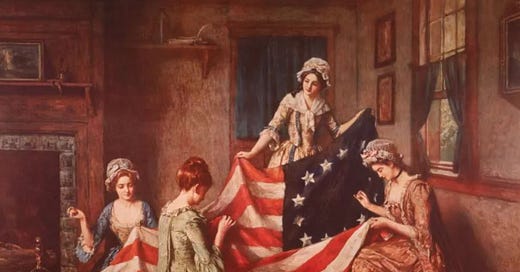TDIH: Battle of Cooch's Bridge
Perhaps the first battle at which the Stars and Stripes were flown?
On this day in 1777, the Battle of Cooch’s Bridge occurs. Some believe this battle was the first at which the Stars and Stripes were flown. Appropriate, if so? This battle was the only Revolutionary War battle to occur in Delaware—later the first state to ratify the Constitution.
The battle occurred mere days after General William Howe had made the long trip up the Chesapeake with a fleet of British ships. The British and Hessians had been cooped up on their ships for weeks. When they finally disembarked at the mouth of the Elk River, they were a bit of a mess. The soldiers lacked fresh food and water, and their horses were doing even worse. Hundreds had died either during the voyage or shortly after landing.
On August 28, Howe dispatched one wing of his army under Hessian Lt. General Wilhelm von Knyphausen. The Hessian general was to forage for cattle and horses for the army. In the meantime, Howe and Charles Cornwallis would continue on to a local village, Head of Elk.
Howe was soon reconnoitering the area. Interestingly, George Washington was then doing the same thing. Indeed, the two generals apparently got a look at each other through their spyglasses as they stood atop opposing hills.
“[W]e observed some officers on a wooded hill opposite us, all of them either in blue and white or blue and red, though one was dressed unobtrusively in a plain gray coat,” one Hessian officer reported. “These gentlemen observed us with their glasses as carefully as we observed them. Those of our officers who know Washington well, maintained that the man in the plain coat was Washington.”
That same day, Washington created a corps of light infantry that included 700 marksmen; he put Brigadier General William Maxwell in charge of this force. The force was to “be constantly near the Enemy and to give ’em every possible annoyance.” He told Maxwell to give the British “as much trouble as you possibly can.”
Maxwell did just that, positioning his men in the area near Iron Hill and Cooch’s Bridge. They would block the road to Wilmington and be prepared to ambush the British. In the meantime, Washington’s main army would stay near Wilmington and build defenses for the larger battle that seemed inevitable.
On September 3, Howe’s army moved a bit south of Maxwell’s position, establishing British headquarters at a local tavern, Aiken’s (or Aikin’s) Tavern. The new location would enable Knyphausen to rendezvous with the main British army. Howe also hoped to outflank the Americans on Iron Hill. Captain Johann Ewald was ordered to take an advance guard of Jägers toward the American position.
They didn’t get too far. Ewald and his six mounted Jägers were ambushed. Ewald managed to escape, calling 400 foot Jägers forward. His mounted Jägers had all been killed or wounded instantly.
A running battle between the Jägers and the Americans ensued. Maxwell’s men attacked in a series of small ambushes. Historian Thomas J. McGuire describes the “classic Ranger-type affair” that ensued “with troops on both sides taking cover and moving through the woods in skirmish order.” The battle raged for hours. One German commander later noted that once the Americans “had shot themselves out of ammunition the fight was carried on with the sword and bayonet.”
Ultimately, Maxwell’s men retreated, returning to join Washington’s main army.
The battle would prove to be a precursor to the much larger Battle of Brandywine about a week later. But that, of course, is a story for another day.
Sources can always be found on my website, here.





Another lesson I knew nothing about. The beginning of the Rangers of US Army fame maybe. A guess. Thank you Tara.
This is another battle I’m not familiar with unless I’ve forgotten. Interesting that it may have been the first battle where the flag was flown. You always include lots of informative details. Great story, Tara.